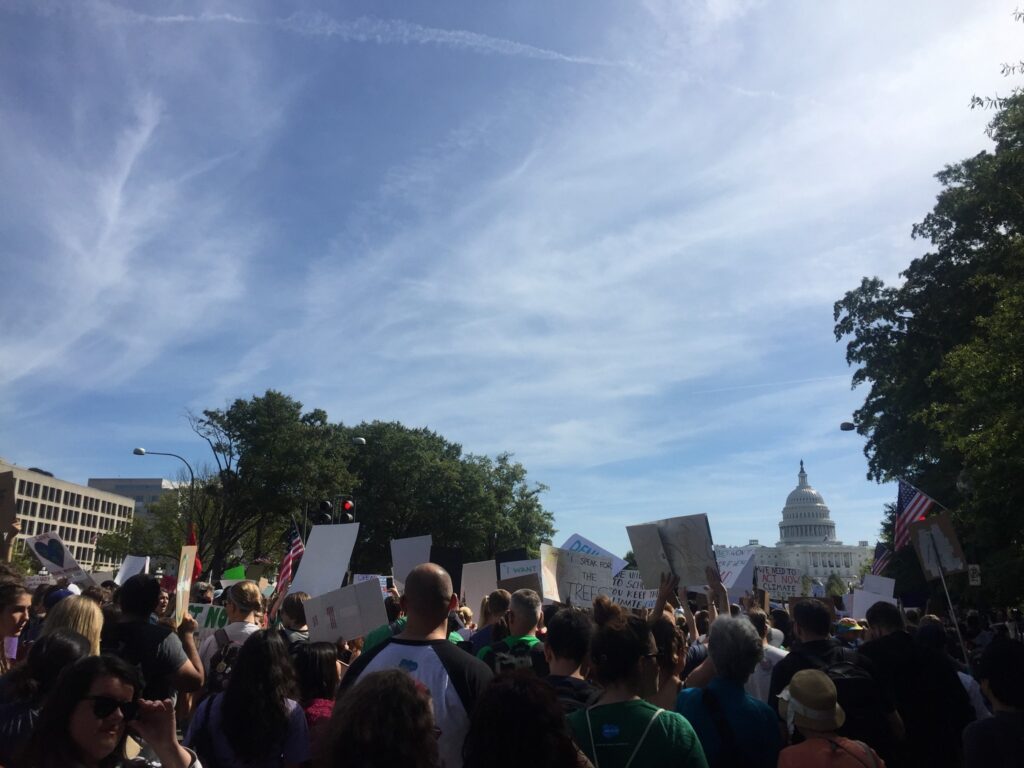
The map on the wall at the Museum of Natural HIstory seemed small, dull even, compared to the wealth of excitement around it – dinosaur bones, wall-sized video displays, models of giant sloths! But what it showed was jaw-dropping.
It was a map of what would be underwater in the U.S. from sea level rise if climate change continues unabated.
As my kids and I looked at it, I explained what they were seeing. They looked carefully at our area on the map, noticing that the ocean was far closer than it is now. Parts of Washington D.C. were likely to be underwater that aren’t now, including places they’ve been. While the city isn’t on the ocean, the wetlands it is built on and rivers that flow through it are heavily influenced by tides from the Chesapeake Bay.
While they would have flitted off to the next thing in other circumstances, they paused, staring at the map. I wasn’t quite sure how to read them. Neither of them seemed anguished, but there was an underlying note of concern in that uncharacteristic pause.
“Hey,” I said to them. “This is the worst case scenario. There are a lot of adults working to prevent this situation, including me.”
As I said these words, I remembered something that had happened a few days earlier. In that situation, both kids were faced with a moral dilemma that while fictional, felt much more concrete.
In the past few months, we’ve started watching Doctor Who as a family. The second episode we watched (The Beast Below) is one of my favorites. It’s a similar idea to the Ursula K. Le Guin short story The Ones Who Walk Away from Omelas. At their core, both stories are about whether it’s right for an entire society to force one person to suffer for their well-being and what happens to the citizens when they learn that secret. In Omelas, it appears that people can either stay or walk away.
But unlike Omelas, the Doctor Who episode presents a third choice. The Doctor’s companion realizes that the creature that the society forced to suffer – in this case, a space whale – wanted to help them. The people never needed to torture it at all! It was only because the humans believed that they had to conquer and cause pain to get a creature to help them that they were in the situation at all.
Despite the happy ending, both my kids were troubled by the idea that people would choose to torture the space whale in the first place. They refused to accept the idea that there was no other option. They saw how pointless and awful the choice was, even if it was abolished by the end.
To reassure them, I affirmed their perspective: “What they initially did was awful. They shouldn’t have tortured the space whale.” But I also considered the bigger picture. “And you’re right – it wasn’t the only choice. Amy found a third way.”
Standing in front of that climate change map, I decided to repeat that point. “It’s just like Amy in Doctor Who. We can find a third way too. We’re working to find a third way – I promise.” Both kids seemed moderately satisfied with that answer and moved on to more exciting parts of the exhibit.
The exchange reminded me that our kids need to know that we are trying our best to do the right thing. Not just in the everyday kindnesses or individual action, like donating to charity, composting, or helping a friend who is sick.
But doing the right thing in the big picture. Not ignoring the crying child of Omelas or the space whale of Doctor Who. Not letting the world drown or burn while we live our lives.
Instead, children need to see us get rid of and rebuild the systems that made that charity necessary. They need to see us working to ensure that no one has to suffer for our well-being. They need to see us remaking our society so it is not built on the backs of others when it never needed to be in the first place. They need to see us find that third way.
It’s not children’s job to fix what we’ve broken, including the climate – it’s ours. While activism can be empowering, kids first and foremost need to know that their most trusted adults in thieir lives are taking action. That’s what lessens anxiety about all of the bad things in the world – knowing that you as their caretakers are working to take care of them.
So go out there – find how you fit in the movement to find and carry out that third way.
If you don’t know how to get involved in climate justice work, check out the Cultivating Climate Justice: At Home Family Action Toolkit and the Climate Action for Tired People toolkit and quiz, both of which I helped develop. Links in comments!